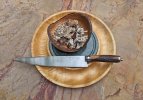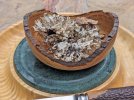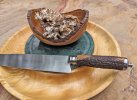I enjoyed photographing my Verijero companion yesterday evening along some bowls
I turned a couple years ago.
The wood used was from the last couple of fire logs we had used while camping at the 1000 Islands National Park.
The logs can be seen resting against the big maple tree.
The logs had some nice spalting going on however they were also a bit soft and mushy in some areas.
I was VERY happy with how the first bowl was "turning" out

... however ...
As I was polishing it for the last time, I increased the rpms of the lathe too much and the bowl came apart sending a chunk of it flying.
I was quite frustrated by this event.
I was reminded of the Japanese art of
"Kintsugi" where broken bowls are repaired with lacquer dusted or mixed with powdered gold, silver, or platinum, As a philosophy, it treats breakage and repair as part of the history of an object, rather than something to disguise.
It is similar to the Japanese philosophy of
wabi-sabi, an embracing of the flawed or imperfect, "sometimes described as one of appreciating beauty that is "imperfect, impermanent, and incomplete" in nature"
I glued it back together and burned the edges.
Today it is one of my favorites bowls

The spalting and the figure in the wood has mellowed out somewhat in the past couple years however it remains just as special to me.




























